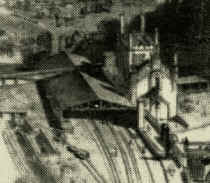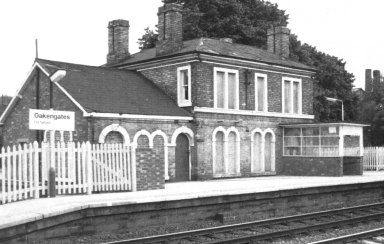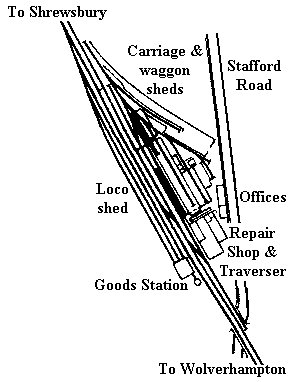|
 |
Rails In Wolverhampton - The Early Years
by Bev Parker |
 |
|
The Shrewsbury &
Birmingham Railway
Beginnings
Right from the start the small company
fell victim to the rivalry between the
large companies. It was formed as the Shrewsbury & Wolverhampton,
Dudley & Birmingham Railway in 1844, at a time when many similar
companies were scrambling for the right to build their own lines. The plan
was to build a line from Shrewsbury to Wolverhampton, with junctions to
Coalbrookdale, the Grand Junction Railway at Wolverhampton, and to
Dudley.
The route from Wolverhampton continued to Birmingham via
Bilston, Darlaston, Wednesbury, West Bromwich, and Smethwick. They
quickly formed an alliance with the London & Birmingham Railway who
saw them as an alternative route to the north. Although the interests of the
London & Birmingham Railway and the Grand Junction Railway were
substantially the same, both companies thoroughly distrusted each other
and quarrelled over the London & Birmingham's Trent Valley line, and the
Grand Junction's claim that Shrewsbury was within its territory.
The
London & Birmingham looked favourably on any scheme that could loosen
its dependence on the Grand Junction. When submitted in 1845, the original
bill was thrown out, mainly because of the opposition from a pro Grand
Junction MP. New plans were hastily prepared in readiness for Parliament in
1846. Robert Stephenson surveyed the line on horseback, and completed the
task in September. At Stephenson's insistence, William Baker was appointed
as Company Engineer.
|
|

The route finally followed by the Shrewsbury & Birmingham
Railway. |
The company changed its name to the Shrewsbury & Birmingham Railway in
January
of the following year, but the first half of 1846 was a difficult year for
the railway.
The
Grand Junction Railway and the London & Birmingham Railway were pressurised
into forming an alliance by their joint shareholders. |
| When the two companies
began to
work together the London & Birmingham withdrew its support for the
Shrewsbury &
Birmingham, which meant that it instantly lost the quarter of its capital
which had been
promised by the London & Birmingham Railway. The new bill was put before
Parliament in June, but wasn't successful, mainly because the company was
now
under-funded and there were 16 other schemes being considered for the same
area.
On August 3rd authorisation was given for a modified route. The
Shrewsbury &
Birmingham could construct a line along the nineteen and a half miles from
Wellington to Wolverhampton. The first ten miles from Shrewsbury to
Wellington
would be shared with the Shropshire Union Railways & Canal Company who were
to build a line from Stafford to Shrewsbury, via Wellington. The Shrewsbury
&
Birmingham were also given a quarter share in the Stour Valley line, and
were given
running powers over it so that they could still reach Birmingham. In 1847
they also
got permission to build a branch from Madeley Junction to Coalbrookdale,
which
would give them access to Madeley Iron Works.
|
Shrewsbury joint station was funded by four companies:
Shrewsbury and Chester Railway.
Shrewsbury and Birmingham Railway.
Shrewsbury and Hereford Railway.
Shropshire Union Railways & Canal Compnay.The track layout
and signalling was designed by Robert Stephenson and Henry
Robertson. The buildings were designed by Thomas K. Penson. |

Shrewsbury station, which opened
on
12th October 1848. |
Construction
The land for the line between
Shrewsbury and Wellington was all purchased by
19th September 1846, and work soon began. With William Baker in charge work
proceeded both on the joint section and the Oakengates tunnel. There were no
great engineering difficulties on the joint section other than two bridges
across the
River Severn. This first section was completed in 1849, and trains began
running
on 1st June, but construction on the eastern section was delayed due to
difficulties
with the 471yard long Oakengates tunnel. |

The viaduct over the River Severn on the
approach to Shrewsbury Station. |
The wet summer of 1848 had also slowed the work
down, and in that year
Edward Banks who was Wolverhampton's leading architect was appointed to
design and oversee the erection of the company's buildings.
The line
approached Wolverhampton via Oxley Hill, and around the eastern side of
Dunstall Hill to Oxley Viaduct.
Workshops, offices, locomotive sheds, and
a goods station were built at Stafford Road. |
The line terminated in a
temporary station on Wednesfield Road because work had not then began
on Queen Street station, which was later known as the High Level station.
On 29th November 1848 the first two carriages were displayed at
Wednesfield Heath station. They were built by the Bromsgrove Railway
and Carriage Co. and were in lake livery with dark blue lining. Further
carriages were built here in Wolverhampton by William Tudor at his
Cleveland Road premises. The railway finally opened on 12th November
1849. |
Running
When the section from Shrewsbury to Wellington opened on 1st June 1849 the
railway began to run trains to and from Oakengates.The initial running
was as follows:
Monday to Saturday, 4 trains each way.
Departures from Shrewsbury at 6.45a.m., 9.35a.m., 4.15p.m., and
6.45p.m.
Departures from Oakengates at 8.45a.m., 2.15p.m., 5.15p.m., and
8.15p.m.
The first and last trains were first class only, the others
were all classes. The journey took 40 minutes. Only two trains
ran on Sundays. |

Oakengates station was a typical Edward Banks design, built in the same brick as Wolverhampton's High Level
Station. |

The headquarters, workshops and goods station
were at Stafford Road. |
On 12th November the eastern section from Oakengates to
Wolverhampton
opened, the inaugural train had 50 carriages and was hauled by 2
locomotives;
Wrekin and Salopian. Passengers wishing to go to Birmingham had to get there
via Wednesfield Heath station as the Stour Valley line from Wolverhampton's
High Level station was still not complete. It would be another 5 years
before
Shrewsbury & Birmingham trains could use their rightful
route to Birmingham.
The frequency of the service was increased to nine trains each way daily,
but
access to the Stour Valley Line wasn't granted until 4th February 1854.
Initially
much work on the line still had to be completed, and even when the line was
opened on 1st July 1852 only London & North Western Railway trains ran on
it for nearly two years. |
| The times of these trains were such as to make
connections with Shrewsbury & Birmingham trains as inconvenient as possible,
the average waiting time was 20 minutes, and the total journey time from
Shrewsbury to Birmingham was 2hours and 10 minutes. The extreme differences
and distrust between the two companies meant that the London & North
Western used every delaying tactic possible to prevent the Shrewsbury &
Birmingham from achieving its goal. Eventually when they were allowed to run
their trains into Birmingham New Street, it was only to last for ten months.
The
last Shrewsbury & Birmingham train ran on the Stour Valley Line on 13th
November 1854 by which time they had amalgamated with the Great Western
Railway, whose line from Wolverhampton Low Level to Birmingham New Street
opened on 14th November. From then on their trains used the Low level
station,
even though work on it was not yet complete. Amalgamation
As early as December 1847 the Shrewsbury & Birmingham Railway made an
approach to the Great Western Railway, as cooperation between the two
companies would be mutually beneficial. This was politely turned down, but
on
10th January 1851 a traffic agreement was signed between the two companies
which led to an offer to amalgamate. This was ideal for the Shrewsbury &
Birmingham who had long suffered the wrath of the London & North Western
Railway, who themselves were bitter enemies of the Great Western.
The
Shrewsbury and Birmingham also had a third share in the Wolverhampton Low
Level station, along with the Oxford Worcester & Wolverhampton Railway, and
the Birmingham Wolverhampton & Dudley Railway. This was allowed under an
Act of Parliament passed on 14th August 1848. The
Shrewsbury & Birmingham
finally became a part of the Great Western Railway on 1st September 1854.
|
 |
Return to the
previous page |
|